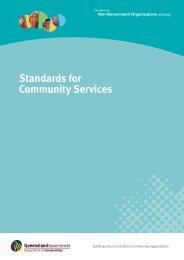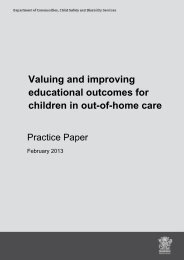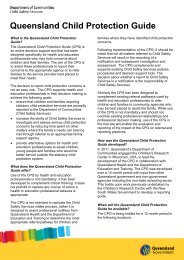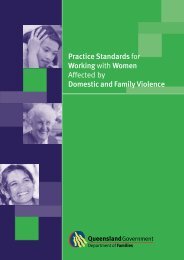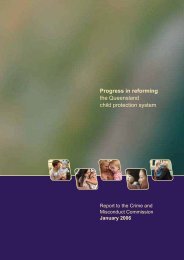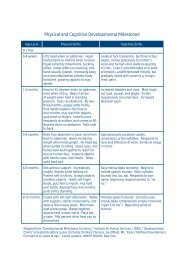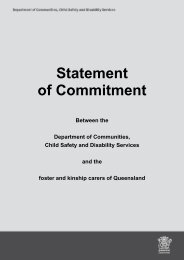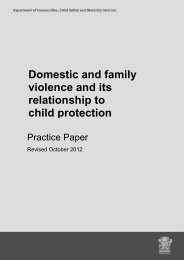Housing and Support Program (HASP): Final Evaluation Report
Housing and Support Program (HASP): Final Evaluation Report
Housing and Support Program (HASP): Final Evaluation Report
Create successful ePaper yourself
Turn your PDF publications into a flip-book with our unique Google optimized e-Paper software.
• Community integration<br />
While eight of the 80 <strong>HASP</strong> clients followed up were<br />
in paid employment, clients worked an average<br />
of 18.06 hours per week. In addition to paid<br />
employment, 13 clients (16.2%) indicated that they<br />
participated in volunteer work. The mean number<br />
of hours spent on volunteer work was 8.15 hours per<br />
week (range = two to 24 hours per week). <strong>Final</strong>ly,<br />
eight clients (10%) indicated that they attended<br />
TAFE or other training programs. Over 40% of clients<br />
indicated that they would like paid employment as<br />
their main activity in the future. This suggests that<br />
there is some scope for clients <strong>and</strong> service providers<br />
to focus on employment as a long-term goal for<br />
those with a desire to work.<br />
• Changes in the need for inpatient care<br />
The average time in inpatient care decreased<br />
signifi cantly (p=0.001) from an average of<br />
227 days/per client in the 12 months prior to<br />
<strong>HASP</strong>, to an average of 18.9 days/per client in the<br />
12 months post-<strong>HASP</strong>. Moreover, the number of<br />
admissions also decreased signifi cantly (p=0.002)<br />
from an average of 1.22 admissions/per client in<br />
the 12 months prior to <strong>HASP</strong>, to an average of 0.66<br />
admissions/per client in the 12 months post-<strong>HASP</strong>.<br />
• Changes in functioning<br />
While improvements in functioning were not<br />
statistically signifi cant, the clients, as a group,<br />
did not deteriorate following entry into <strong>HASP</strong>.<br />
Indeed, the fi ndings indicate that over half of<br />
the clients (51%) demonstrated improvement<br />
in general functioning, while 40% produced<br />
improvement in clinical functioning in the<br />
12 months since joining <strong>HASP</strong>.<br />
• Changes in Mental Health Act status<br />
Restrictions placed on clients through the Mental<br />
Health Act had been signifi cantly relaxed since<br />
entering <strong>HASP</strong>. The proportion of clients on<br />
Involuntary Treatment Orders (ITOs) decreased<br />
from 46% to 22%, while the proportion of clients<br />
with voluntary status increased from 43% to 70%.<br />
This relaxation of the legal restrictions placed<br />
on clients suggests that client functioning <strong>and</strong><br />
compliance with treatment improved following<br />
access to <strong>HASP</strong>. It also demonstrates that efforts<br />
are being made by clinical services to reduce<br />
restrictions on clients where possible.<br />
• Cost – <strong>HASP</strong> versus alternative options<br />
Overall, the recurrent cost of keeping the ‘average’<br />
client in <strong>HASP</strong> for 12 months is approximately<br />
$74,000 less expensive than keeping the same<br />
client in a Community Care Unit (CCU) <strong>and</strong> $178,000<br />
less expensive than keeping the same client in an<br />
acute inpatient unit. The fi ndings suggest that one<br />
could maintain two clients in <strong>HASP</strong> for the cost of<br />
keeping one client in a CCU <strong>and</strong> almost four clients<br />
in <strong>HASP</strong> for the cost of keeping one client in an acute<br />
inpatient unit. However, programs such as <strong>HASP</strong><br />
should not be promoted as a substitute for the<br />
services of a CCU or acute inpatient unit. All of these<br />
treatment <strong>and</strong> housing options should be included<br />
in a comprehensive mental health program. <strong>Final</strong>ly,<br />
it should be noted that the costs provided here are<br />
based on recurrent costs only. Initial costs involved<br />
in selecting clients for the program, securing housing<br />
options <strong>and</strong> establishing infrastructure in the<br />
community to support each individual have not<br />
been considered in our estimates.<br />
• Overall quality of life<br />
An overall rating of quality of life was obtained<br />
by asking clients to rate their quality of life<br />
on a 10-point scale where ‘1’ was the worst quality<br />
of life possible <strong>and</strong> ‘10’ was the best quality of life<br />
possible. <strong>HASP</strong> clients provided a mean rating of<br />
almost ‘7’ out of a possible total score of 10. This<br />
high quality-of-life rating is in keeping with previous<br />
evaluations of clients living in supported housing<br />
in Queensl<strong>and</strong> (Project 300) <strong>and</strong> New South Wales<br />
(The <strong>Housing</strong> <strong>and</strong> <strong>Support</strong> Initiative).<br />
Over 85% of clients were pleased about having<br />
accomplished something in the past month.<br />
These accomplishments included staying well,<br />
being able to stay out of hospital, making a new<br />
friend or getting a job or volunteer work. A further<br />
80% were happy that ‘things had gone their way’<br />
<strong>and</strong> were proud that someone had complimented<br />
them on something they had done (77%).<br />
<strong>Housing</strong> <strong>and</strong> <strong>Support</strong> <strong>Program</strong> (<strong>HASP</strong>)<br />
III



